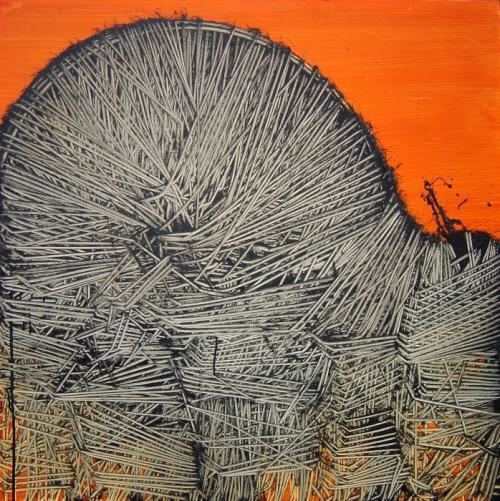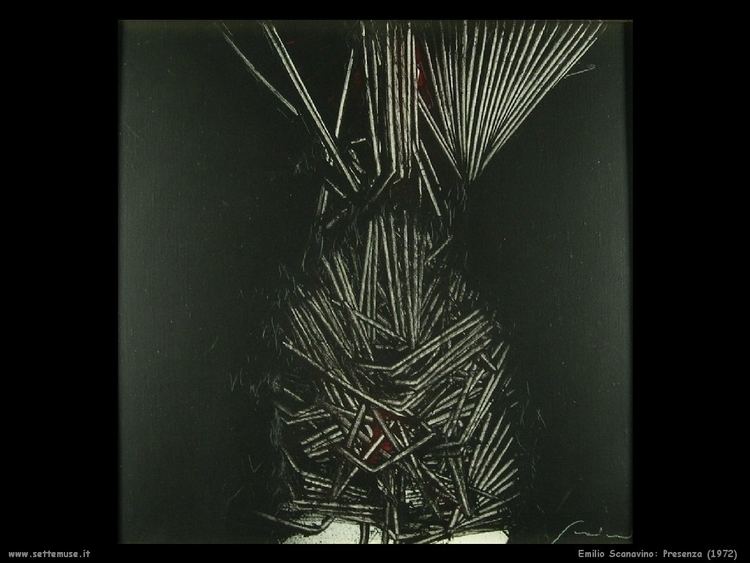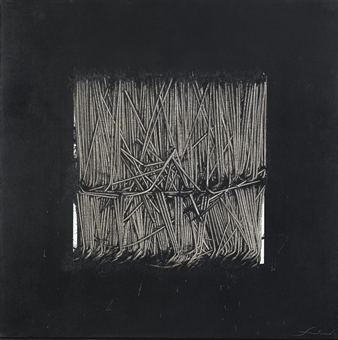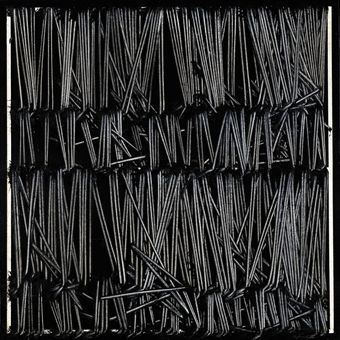Nationality Italian Known for Painting, Sculpture Period Lyrical abstraction | Name Emilio Scanavino | |
 | ||
Full Name Emilio Scanavino Movement Tachism, Lyrical Abstraction Died November 28, 1986, Milan, Italy Artwork Intoppo, Alfabeto senza fine 7, Protetto a meta, Quadro | ||
Emilio scanavino mostra opere dep art milano 2008 catalogo alberto zanchetta wmv
Emilio Scanavino (Genoa, 28 February 1922 – Milan, 28 November 1986) was an Italian painter and sculptor.
Contents
- Emilio scanavino mostra opere dep art milano 2008 catalogo alberto zanchetta wmv
- Archivioarb in ricordo di emilio scanavino 1922 1986
- Early life
- Later life
- Art
- Biography
- References

Archivioarb in ricordo di emilio scanavino 1922 1986
Early life

In 1938 the young Scanavino enrolled to the Art School Nicolò Barabino of Genoa where he met his teacher Mario Calonghi, who had a great influence on Scanavino’s first formation. In 1942 he had his first exhibition at the Salone Romano of Genoa. In the same year he enrolled at the Faculty of Architecture at Milan University. In 1946 he married Giorgina Graglia.

In 1947 Scanavino moved, for the first time, to Paris where he met poets and artists such as Edouard Jaguer, Wols and Camille Bryen. This experience results invaluable on his stylistic grown. He especially assimilated Cubism echoes which he rendered into a personal interpretation since 1948 when he exhibited at the Gallery Isola of Genoa. In the '50 years He was part of the Group "I sette del Numero" of the Numero Gallery in Florence, together the other famous painter Rocco Borella. In 1950 he exhibited at the 25th edition of the Venice Biennale and in 1951 at the Apollinaire Gallery of London in a two-person exhibition with the sculptor Sarah Jackson.

During the sojourn in London he met Philip Martin, Eduardo Paolozzi, Graham Sutherland and Francis Bacon. In the same year he opened his first studio in Milan in an attic of the Foro Bonaparte. Critic Guido Ballo and gallery managers Guido Le Noci and Arturo Schwartz took care of his works.
Next year, 1952, he also worked at Marzotti’s Ceramic Factory in Albissola Marina, where he met many artists and became friends with some of them. Among them there were Lucio Fontana, Asger Jorn, Corneille, Roberto Matta, Wifredo Lam, Giuseppe Capogrossi, Enrico Baj, Sergio Dangelo, Roberto Crippa, Gianni Dova, Agenore Fabbri, Aligi Sassu etc.

In 1954 he exhibited again at the Venice Biennale (27th edition) and next year he received the Graziano Prize. In 1958 he earned Lissone Prize and joined Venezia Biennale with an own room, winning the Prampolini Prize. In the same year he signed a contract with the Naviglio Gallery directed by Carlo Cardazzo with whom he established an important friendship and working relation. He then moved to Milan with his family. Many critics took care of his works. Among them: Enrico Crispolti, Guido Ballo, Giampiero Giani, Edouard Jaguer, Gillo Dorfles, Roberto Sanesi, Franco Russoli and Alain Jouffroy.
Later life
In 1962 he bought an old house at Calice Ligure, which eventually became an atelier. At Milan he met the collector Gianni Malabarba with whom he established a kind friendship.
In 1963 he earned La Spezia Prize while Carlo Cardazzo, whose friendship had supported Scanavino for seven years, suddenly died. This death was a hard loss for the painter. Renato Cardazzo carried on his brother's work as an art trader and he took a great role in spreading Scanavino's name in Italy and abroad.
In 1966 he exhibited again with a personal room at 33rd Venice Biennale, where he won the Pininfarina Prize.
In 1968 he moved his studio at Calice Ligure. A group of artists also moved there, creating a small community around Scanavino.
In 1970 he earned the Gran Prix at Mentone Biennale. Collector Franco Castelli, director of "L'uomo e l'Arte", became his friend and supporter.
In 1971 he survived a hard surgery. The recovery signaled the start of a new creative wave in his painting. He travelled in Belgium, France and Germany but he remained living at Calice Ligure. Between 1973 and 1974 Kunsthalle of Darmstadt exhibited a huge antological exposition that, with some small variation, was also shown in 1974 at Venice's Palazzo Grassi and Milan's Royal Palace.
In 1982, although in failing health, he kept working and exhibiting in public and private places. In 1986 he was invited to exhibit at Rome Quadriennale. He died in Milan on 28 November 1986.
Art
After a figurative start Scanavino's paintings rapidly took Post-Cubist character. Stylization of the forms kept growing until eventually totally fade out in the first 1950 years works. In 1954 his work's characteristic sign started to appear. That is the “stylized knot”, which would characterize all of his following production. The 1950s years works are among the most beautiful of Scanavino's career. Inside them it is possible to see the genesis of the painting transposition of the interiority, with all of its torment, which are the marking point of Scanavino's art.
In his late 1970s years paintings, the “knot” is perfectly defined and recognizable. Painted in anguishing forms, sometimes even threatening and stained of bloody red. Although Scanavino is difficult to place inside a defined artistic movement, he can be considered an informal abstractist, close to the Abstract Expressionism and Hans Hartung and Georges Mathieu's art.
